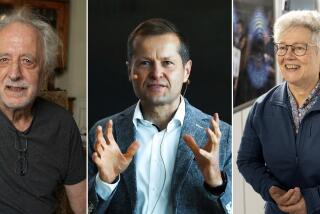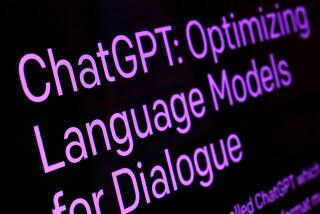Computer Network Serves as Global Classroom
- Share via
BOSTON — Several times a week in his room at Oberlin College in Ohio, junior Matt Trawick talks to Michael Haass and Eva Steininger about the paradoxical behavior of objects moving near the speed of light.
That’s not unusual since all three students take the same course on Einstein’s theory of relativity. What is unusual is that Haass attends the University of West Florida and Steininger is at the University of Vienna in Austria.
They are part of a 13-week course--the first of its kind--linking 26 students and five physics professors at seven colleges in the United States and Europe.
Trawick’s desktop computer is tied to Oberlin’s main computer, which in turn is tied to an international campus network called Bitnet, made up of 2,500 computers at 800 schools and normally used only as a data bank. He gets physics assignments twice a week from course headquarters at the University of West Florida. Twice a week, he sends back completed problems.
In the meantime, Trawick is involved in a rich give-and-take with the members of his “class” all over the Western Hemisphere. He gets and sends about 10 messages a day from fellow students and professors--in what often becomes a protracted “bull session” in which students try to poke holes in Einstein’s theories.
Students explore and explain in writing why, for example, time slows down as speed increases, and why it’s impossible for particles to reach the speed of light. They have to articulate new concepts every step of the way.
Richard Smith of the University of West Florida, the course organizer, hopes it will lead to more “multiversity” computer courses in which undergraduates exchange ideas and come into contact with top-ranking professors. Edwin Taylor of the Massachusetts Institute of Technology, who, with famed theorist John Archibald Wheeler, wrote the textbook that students use, participates in the course.
But getting students to reflect, think through problems and especially write ideas is the key, said Smith. It’s what separates the course from a typical classroom.
“Science students in general are rotten writers,” he said. “They don’t have familiarity with words, and they are too anxious to plug into equations without thinking about the reality of the ideas they are working with. We want them to get into the habit of thinking before they punch numbers into a calculator.”
Trawick says it’s one of the best courses he has taken: “Einstein’s ideas are very complex and sneaky and have all these lurking paradoxes. By writing them out rather than fiddling with them in your head, you come to understand them.”
Trawick has found himself solving problems simply by “stating the questions clearly enough.”
“John Wheeler says if you think through a problem long enough, you don’t have to compute anything--the answer becomes self-evident,” Smith said. “Of course, he’s a big gun. But that’s the direction we are trying to move in.”
Other students such as Haass found that writing about physics makes it less intimidating. He came to find that the speed of light, for example, operates as a simple function in physics--not some magical number.
Physics, with its exploratory, problem-solving focus, is a course tailor-made for computer networking. Not all are, however, experts say. Lecture courses in history, English or math may not be as suited for free-floating study, they point out.
Computer courses are not new. Other colleges have experimented with them--the New School for Social Research and New York Institute of Technology, for example. The operating cost of such courses is high, however, because of phone bills that the Bitnet system, with its series of interlinking campuses, can avoid. Nor do they involve a wide range of colleges.
The course doesn’t save time, Taylor said. It doesn’t save money or cut down the number of teachers needed. “But it forces kids to clarify their thinking and communicate ideas. You want to see that.”
Oberlin junior Anthony Anderson likes the fact that “you don’t have to be in class at a scheduled time.” He was excited by a recent discussion on “space-time intervals,” in which he suggested that an imaginary number be used in an equation instead of a minus sign typically used in the Pythagorean Theorem: “It wasn’t an original idea, exactly; Stephen Hawking has an equation where time is imaginary--but it caused a lot of stir.”
Still, it’s the free-ranging discussions that students like most.
The “relativity of simultaneity theory” sparked the best bull session so far. In this theory, events that appear to someone standing still to happen at the same time appear to an observer moving at high speed to happen at different times.
One student conjured a scenario in which two rabbits beside a railroad track are struck by lightning. To a stationary observer, both rabbits seem to be hit at the same time, but to the person watching from a passing rail car, one rabbit is struck first.
What would happen, the student asked, if a supersensitive carbon dating test were applied to both rabbits: Would this “objective” test show them to have been hit at the same time or not?
“We finally figured that out, but I’m not sure I can explain it,” Trawick said.
Other participating schools include Boise State University in Idaho; Dickinson College in Carlisle, Pa.; New Mexico State University in Las Cruces, and Towson State University in Baltimore.
More to Read
Sign up for Essential California
The most important California stories and recommendations in your inbox every morning.
You may occasionally receive promotional content from the Los Angeles Times.













